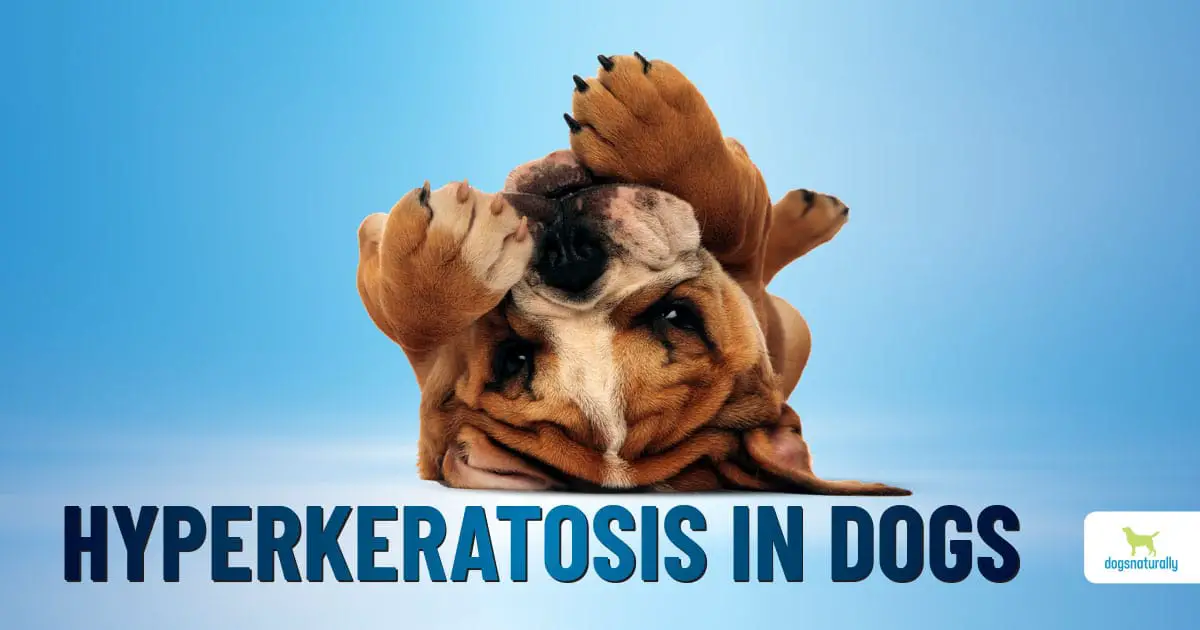You might think your dog’s crusty nose or flaky paws are just a result of environmental dryness. But it might be a condition known as hyperkeratosis in dogs.
What Is Hyperkeratosis?
Keratin is a protein in the outer coating of the skin, hair and nails. It’s a tough, fibrous protein that your dog makes naturally to protect these structures. But an unusual overgrowth of keratin is called hyperkeratosis.
Hyperkeratosis is typically visible as cracked crusts on your dog’s nose or paws. Hyperkeratosis can be painful for dogs if appears on his paws especially and you might notice limping. And because your dog sweats through his paws, it could affect your dog’s ability to regulate his temperature in hot weather.
But what you won’t notice is its effect on your dog’s nose. When a crusty shell forms over the nose, the dog’s sense of smell can be affected. Skin cracks also are an ideal area for bacteria to accumulate, which can lead to skin infections.
What Causes Hyperkeratosis In Dogs?
There are a number of causes of hyperkeratosis in dogs.
- Age
Hyperkeratosis is more common in middle-aged or older dogs. The skin naturally thickens as dogs age, which can lead to calluses and hyperkeratosis. - Genetics
Some breeds are more susceptible to hyperkeratosis, including Cocker Spaniels, Dogues de Bordeaux, Irish Terriers, Labradors, brachycephalic breeds, Boxers, English Bulldogs, French Terriers, Bedlington Terriers and Golden Retrievers. - Zinc Deficiency
Zinc deficiency can lead to excessive amounts of keratin, as well as conditions like zinc dermatosis. - Infectious Diseases
Distemper, a viral infection or papillomavirus can cause hyperkeratosis. - Parasites
A sandfly bite can cause Leishmaniasis; a type of parasite which can lead to overproduction of keratin. - Autoimmune Disease
Autoimmune diseases like pemphigus foliaceus can cause your dog’s immune system to attack the connections linking skin cells. This causes an over-production of keratin, causing cracked and dry skin.
Is Hyperkeratosis Painful For Dogs?
In most cases, hyperkeratosis is not life-threatening and most cases are harmless. But it can still be painful for your dog. Left untreated, dogs with hyperkeratosis can find it painful to walk or stand. There is no known cure for hyperkeratosis, but the pain can still be managed.
What Are The Signs Of Hyperkeratosis?
It’s fairly easy to spot the signs of hyperkeratosis in dogs. Look for:
- The appearance of thick, hairy growths on the pads of the feet.
- Unbalanced gait caused by the thickening of his pads.
- Thick, scarred tissue on the paws or nose.
- Paw licking
- Excessively dry nose, possibly with blisters.
- Cracked paw pads or infected nails.
- Reduced activity or lameness.
- Pain when the paws, nose or ears are touched.
- Loss of color in the nose, paws or ears.
If you suspect hyperkeratosis in your dog, you can ask your vet to run bloodwork to confirm an infection, zinc deficiency or other potential causes. Fortunately, you can manage hyperkeratosis naturally to make it less painful for your dog.
RELATED: CBD Oil For Dogs: How It can help with pain ,,,
Home Remedies For Hyperkeratosis in Dogs
While there isn’t a cure for hyperkeratosis in dogs, you can manage the symptoms Here are some one remedies you can try:
Trim Excess Keratin
You can trim the excess keratin from your dog’s paws. You can ask your vet or your groomer to show you how do it safely. To trim excess keratin:
- Gently clip the crusty layers around the afflicted area.
- Follow the surface to avoid cutting your dog’s skin.
Use Booties
Try using booties or socks on your dog to protect the skin on his paws. When you minimize irritation, you can reduce the risk of hyperkeratosis.
Avoid Parasites
Protect your dog from environmental factors like dirty water and keep your yard clean to avoid infections and parasites.
Feed A Healthy Diet
Feed your dog a balanced whole food, raw diet to prevent zinc deficiency and maintain a healthy immune system.
Do A Foot Soak
Soak your dog’s feet in warm water with Epsom salts for 15 minutes. This can relieve the pain caused by hyperkeratosis and makes it easier to trim excess skin from the pads.
RELATED:Home remedies for sore dog paws ,,,
Apply A Natural Balm
Combine natural remedies such as calendula and chamomile with shea butter, ghee or MCT oil. Rub this into your dog’s nose or paws to soften and bring relief.
Natural Antibiotics And Antifungals
If your dog has a skin infection along with hyperkeratosis, you can apply Manuka honey, which has antibiotic properties. You can also make a medicated balm. Combine one drop of oil or oregano with an ounce of shea butter, ghee or MCT oil. Oil of oregano is very potent and has antibacterial, antiviral, antiparasitic and antifungal properties.
How Can You Help Your Dog?
You’ll want to avoid making hyperkeratosis painful for your dog by recognizing the condition as soon as possible. Try combining these home remedies to help reduce the the pain associated with hyperkeratosis in dogs.
